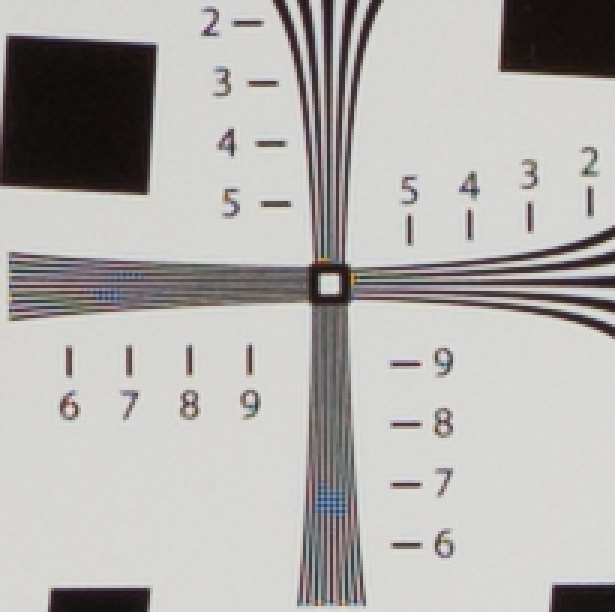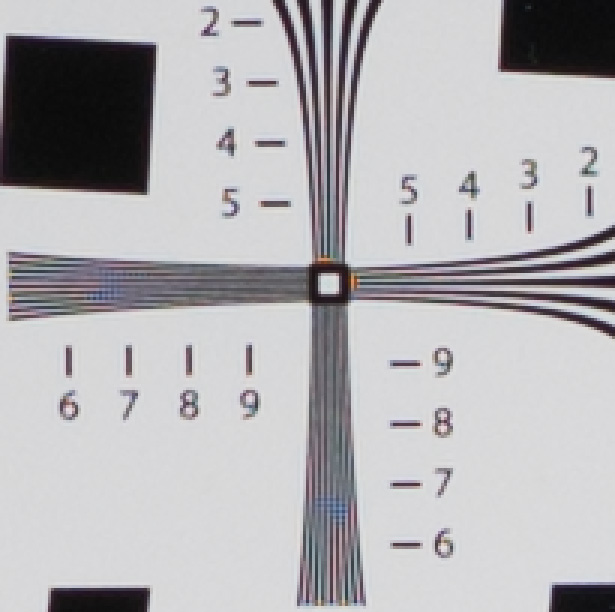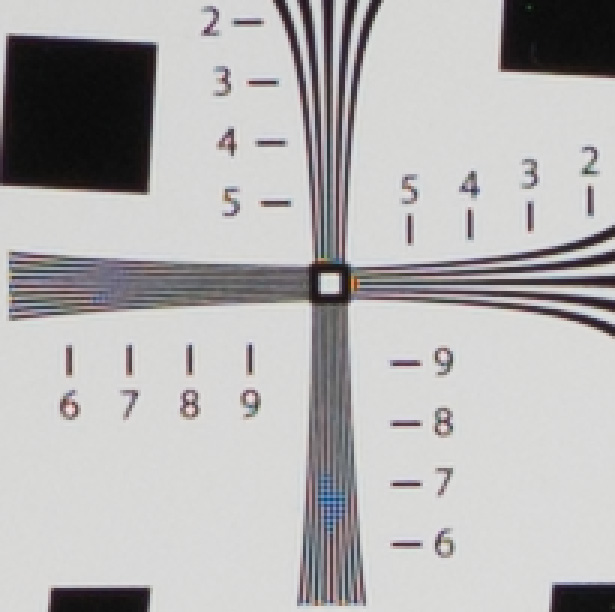I’ve had interest in comparing a normal lens on the D800E with the Sony a7R/Zony 55 results.
I set up this gear: AFS Nikkor 58mm f/1.4G on a D800E, RRS D800 L-bracket, Arca Swiss C1 Cube, RRS TVC-44 legs. Release in mirror up mode, with a programmed 5 second delay between mirror up and shutter tripping. ISO 100, lens set at f/5.6. ISO 12233 target with the camera at a distance to yield an active area about 700 pixels high. Thus, the lines labeled “7” represent 1 line pair per pixel pair.
I focused manually, wide open using the D800E’s most magnified live view setting. Live view on the D800E is as bad as live view on the a7R is good, but I’m pretty sure I got an accurate focus.
Target illumination for the continuous lighting images was provided by a single Fotodiox LED-200WA-56 lamp using the supplied reflector. Lighting for the strobe images came from a Paul Buff Einstein 640 watt-second flash set to 2.5 watt-seconds. At this power setting, the flash duration is about 1/13000 second. The camera was set to trailing curtain synch and the shutter to 3.2 seconds, allowing the camera to stabilize from the shock of the first curtain movement before the flash went off.
For the continuous-lighting pictures, the camera was set to 1/500 second with the Fotodiox at maximum output. An exposure was made. Then the shutter was set 1/3 stop slower, the light adjusted to give the same meter reading, and another exposure effected. That process was repeated all the way to a shutter speed of 1/4 second, with some gaps where the Fotodiox brightness steps were over 1/3 stop.
I processed the images in Lightroom with the default settings, corrected for (minor, as it turns out) exposure differences, and exported the files to Lightroom as layers. I labeled the layers with the exposure times and compared them. The images that I’m posting here are crops from the upper right-hand corner, enlarged 3x using nearest neighbor, and JPEG’d. Because of the way that Photoshop handles EXIF data from images composed of multiple layers, the EXIF data for the posted images is bogus. If anyone would like to see the Photoshop stack, please contact me.
The strobe image is the highest contrast, but not by much:
1/500 second looks good too, but it’s not as punchy as the strobe picture:
All the other pictures are very similar to the 1/500 one. There’s a tiny, tiny loss in quality in the region around 1/125. Here’s 1/80.
This test proves that shutter shock is not a problem with the D800E and the 58mm f/1.4, at least in landscape orientation with the mirror locked up.



Here’s a communication I just got from a reader:
“Thanks Jim for the normal lens test with a7r and d800e. Unfortunate that the a7r doesn’t shout BINGO! And unfortunate that I am now bouncing back and forth between returning to the d800e or ameliorating the a7r shutter shake with some work around inspired by Joe Holmes.
I think I’ll wait to see if Sony or Nikon or Canon gets it right in the next camera go round. ”
Except for the live view, I think Nikon got it pretty close to right in the D800E. It’s not an EVIL camera, though; maybe that’s what you mean. It doesn’t have quite the D4’s ergonomics either, but it’s pretty darned good if what you want is high IQ.
Jim